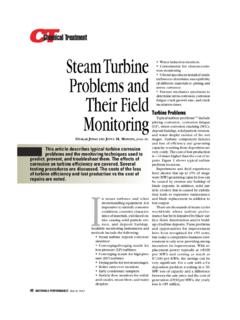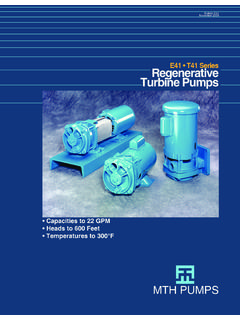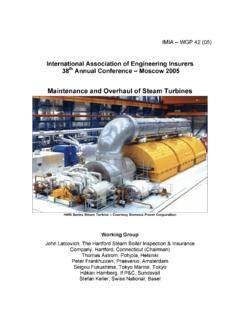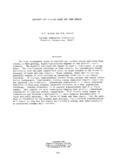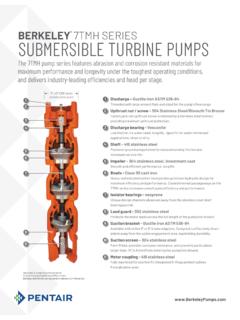Transcription of Stress Corrosion Cracking on Steam Turbine Rotor …
1 Stress Corrosion Cracking on Steam Turbine Rotor Grooves: Experiences and Countermeasures from EGAT Power Plants Kobchai Wasuthalainan, Kanit Nangkala, and Santhiti Chantha-Uthai Electricity Generating Authority of Thailand (EGAT), Thailand Abstract Although Stress Corrosion Cracking (SCC) can occur in many locations of Steam Turbine , most of them initiate at LP disc rim, Rotor groove or blade attachment area. Usually power plants operating more than 15 years are susceptible to this failure mechanism. If SCC happens, especially in Rotor groove, it has a major influence on Steam Turbine life. Because of the complexity of crack growth behavior, it is difficult to estimate the remaining life of the Rotor with cracks found.
2 In some cases short term remedies are urgently needed in order to return the unit back in operation before long term actions can be decided. For our Steam turbines in Electricity Generating Authority of Thailand (EGAT) that faced such problem, we had many experiences and countermeasures both from Original Equipment Manufacturers (OEMs) and in-house learning by doing. Several corrective actions, for example blades cutting (partial or entire row) with or without 1/19. baffle plate installed, skin machining with retouching included, removal of all blades from row, continuing in operation with periodical inspection, or even retrofitting will yield different results and different costs-benefits. Maximum crack depth, allowed outage duration, spare parts and repair cost are the key factors for deciding on which suitable actions to be taken.
3 Countermeasures from EGAT experiences may be used as a guideline for other units which encounter similar problem. 1. Introduction of Stress Corrosion Cracking Mechanism In LP Turbine section, Cracking on Rotor due to SCC has been most prevalent in fir-tree or inverted fir-tree groove designs but it also has been noted in other designs such as finger type design.[3] Cracks initiate from surface especially around the notches of the grooves and propagate across the steeples. Failure mechanism is a function of Stress intensity, Rotor material, and Steam environment so that the probability of occurrence is higher in the longer last stage blades when the moisture of condensation begins to form. Figure 1 shows an example of SCC found on LP Rotor groove Figure 1 Example of Stress Corrosion Cracking on LP Rotor groove (left) crack and pitting Corrosion at LP Rotor groove (right) microstructure of crack examined by replication Corrosion induced cracks are brittle, usually branching, and may be either trans- granular or inter-granular depending upon the material composition, Stress levels, and corrosive environment.
4 [3] However for EGAT Steam Turbine rotors that are subject to 2/19. some heat treatment processes, it can be seen from figure 1 that SCC exhibits multi- branched inter-granular crack pattern in martensitic steel. Crack propagation rate from SCC can be divided into 3 regions as a function of applied Stress intensity factor (KI) which are dependent, constant, and approaching final failure.[3] In the first phase, SCC can only propagate when Stress intensity at Rotor groove exceeds the threshold of the crack growth (KISCC). When KI<KISCC, indication may be in the form of localized Corrosion and its magnitude or degree of severity becomes less significant. The time for Cracking is influenced by many parameters especially from applied Stress , yield strength of material, service temperature, and Steam conditions.
5 For the second phase, crack growth rate is assumed to be constant and independent from applied load or KI. We call this region plateau region. After stable growth phase, SCC. may change its mode to Low Cycle Fatigue (LCF) or High Cycle Fatigue (HCF). The crack is accelerated into unstable regime hence fast fracture will soon come. SCC can cause a catastrophic failure on Steam Turbine and related equipments. Following consequences of SCC may result in extensive outage shutdowns, expensive countermeasures, or even plant derates. 2. Life Assessment Program and Methods of Evaluation Despite difficulty of predicting the time of early developing crack, SCC may have been detected after 15 years of operation or more.
6 It is our typical standard to perform life assessment for most EGAT Steam turbines between 15 to 20 years after commercial operation. Period of inspection will be considered by optimizing plant life cycle cost, resource available, and demand for electricity. LP Rotor groove inspection program consists of blade removal, groove cleaning and magnetic particle examination with replication test to verify indication dimensions. Normally in EGAT power plants, shutdown interval of Steam Turbine life assessment ranges approximately from 45 to 60. days depending on scope of work. 3/19. Figure 2 Replication test after several indications on Rotor grooves were found Once SCC was found, actual crack dimensions had been recorded for reference.
7 In addition, the most two crucial things to be determined are critical crack depth and crack growth rate. The critical crack depth (acr) can be calculated by Finite Element Analysis (FEA) software where acr is the minimum crack depth that the applied Stress intensity factor (KI) exceeds the material toughness (KIC).[1] Note that KI is the function of assumed crack geometry or flaw shape and KIC depends on material properties. Since plateau crack growth rate during stable or constant growth period was purposed in generic form as da C. ln = C1 2 + C3 y [1]. dt T. where da = the crack growth rate dt C1 , C2 , C3 = material constants T = the operating temperature of the disc y = the room temperature yield strength of the disc Hence, the remaining life of Turbine Rotor from static Stress during operation can be computed from acr ai [1].
8 Tr =. da .. dt . where 4/19. da = the crack growth rate dt tr = the remaining life acr = the critical crack depth ai = the detected crack depth In general, there is not only static Stress during normal operating conditions but also dynamic Stress which eventually be generated from cyclic operation. Frequent numbers of unit start/stop can stimulate dynamic loads when temperature gradients in Steam Turbine Rotor increase. This behavior acts as a driving force to build up the defects. If the cyclic Stress intensity ( K) is greater than the threshold value ( Kth), fatigue Cracking will combine with SCC. Suitable model for crack growth prediction should be able to cope with HCF or LCF in the latter case.
9 Dynamic crack growth can be expressed as da = C ( K ) [2]. n dN. where da = the crack growth rate dN. C , n = empirical constants K = the cyclic Stress intensity factor However the method of remaining life evaluation for SCC damage mechanism is quite like a step by step procedure. Practically, there are many uncertainties or errors occur, for example flaw sizing, Non-Destructive Test (NDT) methods, scatter data on KIC. from laboratory, or error from calculation. Deterministic approach may result in pessimistic or optimistic outcomes. Therefore probabilistic analysis that considers input probability functions by using Monte Carlo Simulation may present a more realistic outcome. For this reason, determination of remaining life is not a simple task so EGAT.
10 Occasionally consults OEMs or specialists in order to confirm the evaluation results for making further corrective actions. 5/19. 3. EGAT's Experiences and Countermeasures From our EGAT's Steam Turbine fleet maintenance historical records, Rotor groove inspection program has been first carried out since November 1997 for detecting SCC. There are 12 out of 46 units which indications were found including LP Steam Turbine rotors from EGAT subsidiary companies such as Electricity Generating Company (EGCO) and Ratchaburi Electricity Generating Company (RGCO). However, we have not counted for South Bangkok Combined Cycle Block 3 (SB-C30), Bankpakong Combined Cycle Block 5 (BPK-C50), and Chana Combined Cycle Block 1 (CNP-C10).
